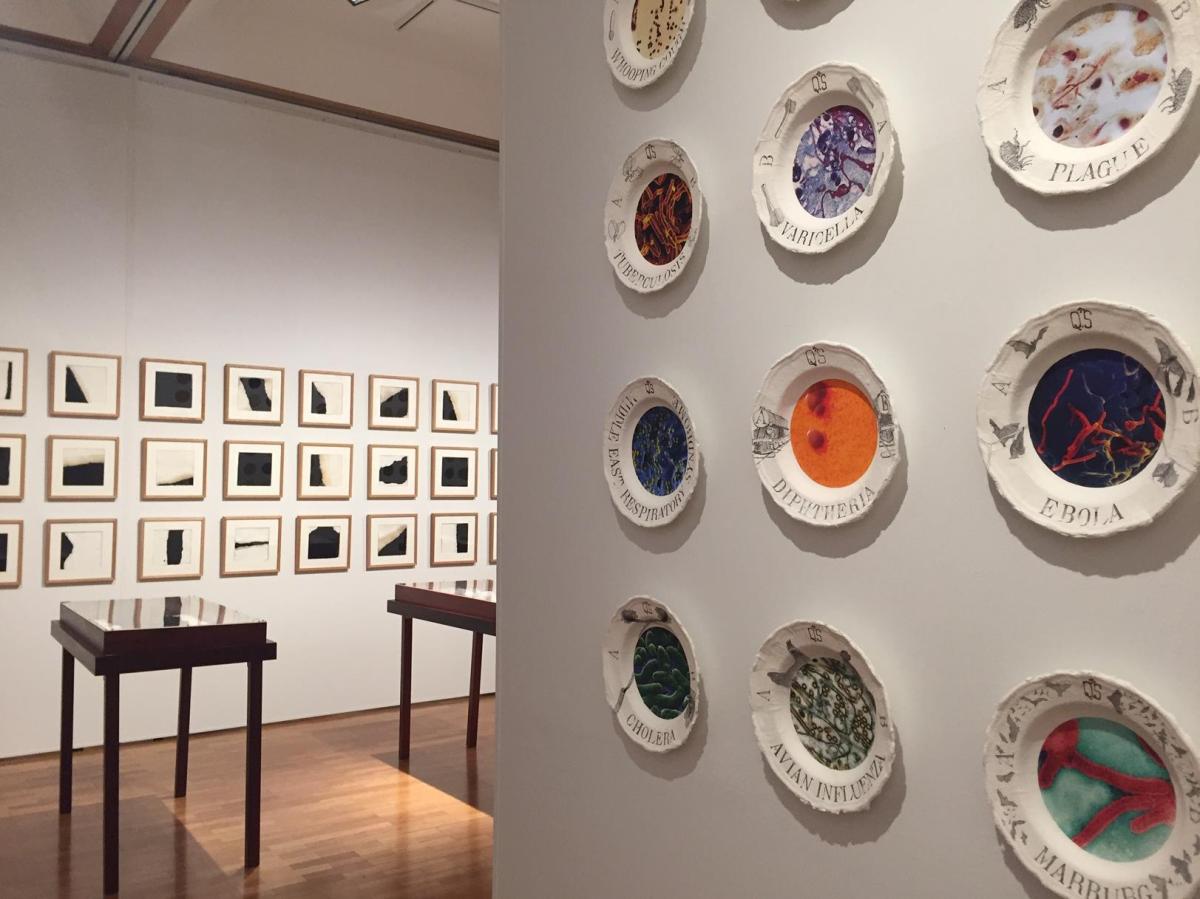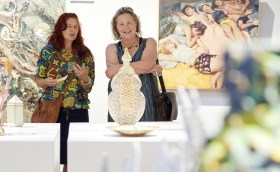Installation view of Nathalie Hartog-Gautier’s North Head Project (2017) at Gosford Regional Gallery. Photo: ArtsHub.
It’s hard to imagine that in this 21st century, our global community is again facing the rise of a measles epidemic, especially given that a vaccine has been available since 1963.
It is a subtle consideration that artist Nathalie Hartog-Gautier revisits in her installation North Head Project (2017), a suite of works made on paper during a residency at the Quarantine Station in Manly (NSW).
There, between 1832 to 1984, migrants had to go through a disinfecting carbolic acid shower to prevent the spread of disease. They were also classified into two groups: A for Alien and B for British, explains Hartog-Gautier.
Somehow the use of paper as a medium matches the fragility of both these stories, imprinted with memory, tension, disrespect, but also very much a contemporary story of how we question history, our social responsibility, and our impact on the environment.
Hartog-Gautier explains that her choice of hand-made paper, which she then casts into forms, is because it reads a little like Braille. ‘It allows me to record the shapes and details of the place, evocative for words; casted [sic] corrugated metal from the shower recess, bolts and nuts are punctuations of migrants’ stories’.
One is witness to that history as delicate tiles of paper are impregnated with the architecture of this site; their white, almost ghost-like forms seduce and intrigue.
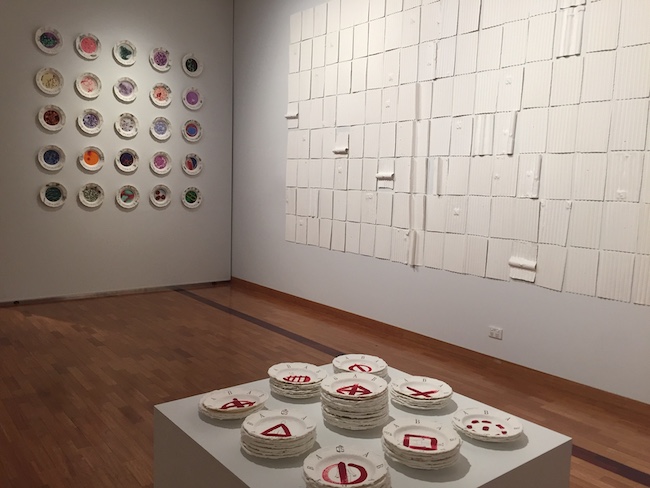
Installation view of Nathalie Hartog-Gautier’s North Head Project (2017) at Gosford Regional Gallery. Photo: ArtsHub.
These stories sit in a beautiful conversation around the notion of impact – our impact through our decisions – with the sight lines across the gallery space melding with another work, Fissures (2019), which explores the threat of coal mining.
Created during a residency in the Blue Mountains, here Hartog-Gautier has collected charcoal and ochre pigments which have been cast into paper water bottles to reference the leakages that affects waterways in coal mining areas.
‘They are presented as specimens in cabinets as precious references we should not forget and should save as memory for future generations,’ writes Hartog-Gautier.
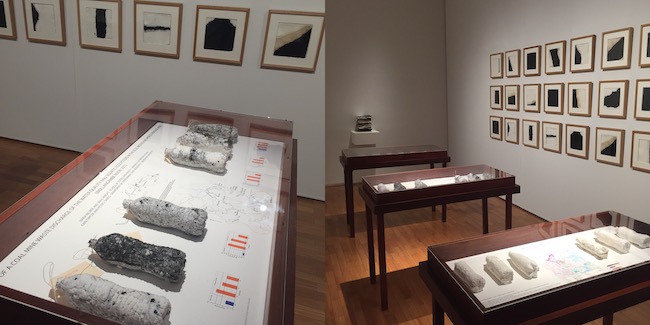
Installation view of Nathalie Hartog-Gautier’s Fissures (2019) at Gosford Regional Gallery. Photo: ArtsHub.
These powerful series are presented alongside equally powerful works by Indigenous artist Beverly Smith, who also uses the medium of paper as narrative.
Smith rather uses natural dyes from indigenous trees, earth pigments of ochre, sand, earth, and binders to tell visual stories connected to her Aboriginal identity and connection to Country.
As the Gallery’s curator writes: ‘For centuries paper has been used as a medium for keeping record and holding memory.’
This two-person exhibition, Paper & Place, is currently on show at Gosford Art Gallery, on NSW’s Central Coast, and is a superbly curated and presented exhibition.
Viewers encounter Smith’s body of work first – a suite of fluid drawings that are presented on the floor central to the gallery, gritty and rich in their natural pigments. Others (not mapped out) sit piled behind them, hovering on a floating wall-mounted shelf.
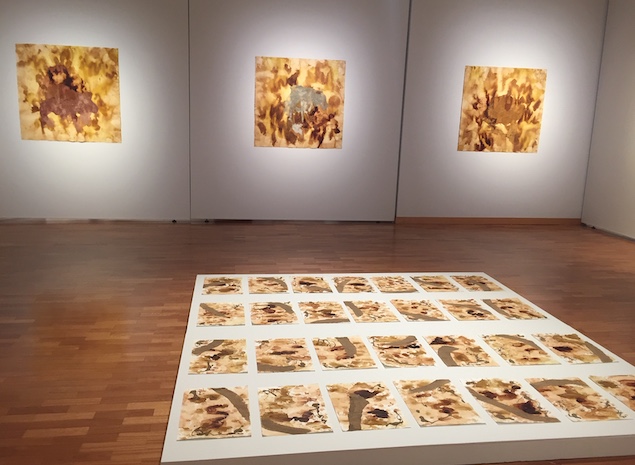
Installation view of Beverly Smith, Gosford Regional Gallery. Photo: ArtsHub.
You can almost feel the spiritual connection to Country in Smith’s A book of Brewarrina, Bourke and Cobar (From Memoires of my own series) 2017; it is an incredibly palpable personal expression. It feels at once harsh yet beautiful; eroding yet regenerating.
There is a particularly sensitive connection between Smith and Hartog-Gautier’s work, where on the end wall, Smith presents three works from her Organic matter (family medical history) series 2017-2019, where ochres and pigments start to look as if examinations under a laboratory microscope. It has an interesting connection with Hartog-Gautier’s North Head Project (2017) and its catalogue of introduced diseases – both artists stitching history to contemporary concerns.
This is fabulous example of how a concise and considered exhibition can sit together without the strained bravado and fanfare we so often see, but rather allows each body of work to sing and slowly unfold; the integrity of each artists making to shine and yet offering a sympathetic connection through medium.
It is aesthetically beautiful, technically top-drawer and is erudite and current, pushing the viewer to gently find their own questions and considerations in our relationship with this land we live upon.
4 stars out of 5 ★★★★
Paper & Place: Nathalie Hartog-Gautier and Beverly Smith
25 May – 7 July 2019
Gosford Art Gallery, NSW
